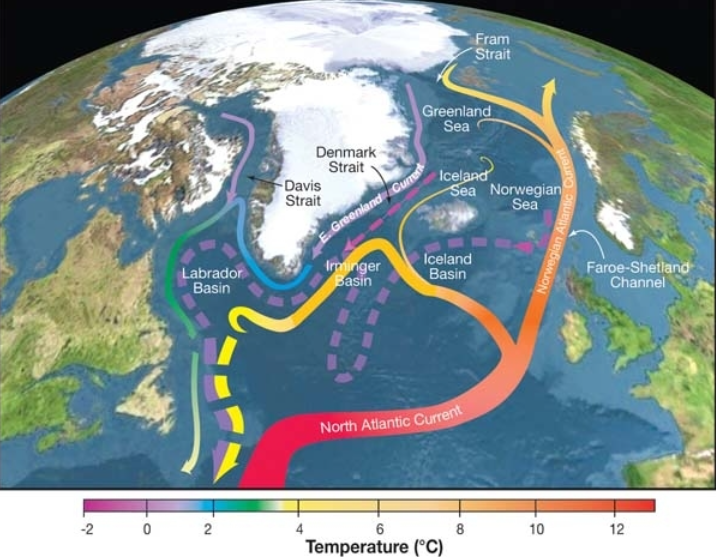Gulfstream “barely impacted” by Arctic ice melt
By Die kalte Sonne
(German text translated/edited by P Gosselin)

Arctic ice melt barely impacting AMOC. Day After Tomorrow scenario remains fantasy, new study suggests. Figure: R. Curry, http://editors.eol.org/eoearth/wiki/File:OCP07_Fig-6.jpg; CC BY 3.0
Stefan Rahmstorf never tires of claiming the Gulf Stream system (AMOC, Atlantic Meridional Overturning Circulation) is being strongly weakened by the fresh water input of the melting Greenland ice. In his Klimalounge blog at the end of January 2019 he wrote:
”The physics behind how global warming and ice melt (both without a doubt caused by man) is slowing down the AMOC is understood …”
Yet, on April 26, 2019, Dukhovskoy et al published a new paper in the JGR Oceans, which concludes that Greenland’s meltwater is having little impact on the AMOC:
Role of Greenland Freshwater Anomaly in the Recent Freshening of the Subpolar North Atlantic
The cumulative Greenland freshwater flux anomaly has exceeded 5000 km3 since the 1990s. The volume of this surplus fresh water is expected to cause substantial freshening in the North Atlantic. Analysis of hydrographic observations in the subpolar seas reveal freshening signals in the 2010s. The sources of this freshening are yet to be determined. In this study, the relationship between the surplus Greenland freshwater flux and this freshening is tested by analyzing the propagation of the Greenland freshwater anomaly and its impact on salinity in the subpolar North Atlantic based on observational data and numerical experiments with and without the Greenland runoff. A passive tracer is continuously released during the simulations at freshwater sources along the coast of Greenland to track the Greenland freshwater anomaly. Tracer budget analysis shows that 44% of the volume of the Greenland freshwater anomaly is retained in the subpolar North Atlantic by the end of the simulation. This volume is sufficient to cause strong freshening in the subpolar seas if it stays in the upper 50–100 m. However, in the model the anomaly is mixed down to several hundred meters of the water column resulting in smaller magnitudes of freshening compared to the observations. Therefore, the simulations suggest that the accelerated Greenland melting would not be sufficient to cause the observed freshening in the subpolar seas and other sources of fresh water have contributed to the freshening. Impacts on salinity in the subpolar seas of the freshwater transport through Fram Strait and precipitation are discussed.”
In the main text, it is stated:
“This result agrees with the previous study of Saenko et al. (2017), who also show that the GFWA of similar magnitude (and even double of this magnitude) has negligibly small impact on the SPNA thermohaline fields, barely impacting AMOC.”
GFWA means the meltwater anomaly from Greenland and SPNA of subpolar North Atlantic. A study from 2017 finds something similar, which of course does not get mentioned by Rahmstorf in January, 2019. The fresh water from Greenland is mixed down to depths of 1000 m and thus the amount is practically meaningless for the AMOC, the paper finds.
What now?
For years we have been hearing from certain circles of climate research that we are melting the Greenland ice sheet and thus a “Day After Tomorrow” scenario gets conjured up. But a very recent paper finds that this is not the case. And when we report on it, are we thereby questioning the “credibility of climate science”, or are we correctly reflecting the progress made in climate research because the work is getting cited? Climate alarmists are desperately trying to convey the wrong image of a monolithic “climate science”, which in reality does not exist at all.





It is said that Ben Franklin took measurements of the Gulf Stream on a return trip to North America from Europe. Ol’Ben would have been thrilled to have all the new information.
~ ~ ~
As the map shows, the information here is mostly about the North Atlantic extension. The warmth of the Gulf Stream has mostly dissipated by the time the water passes the eastern edge of the Outer Banks; the Flemish Cap (located within an area of transition between the cold waters of the Labrador Current and warmer waters influenced by the Gulf Stream).
Image: https://www.weatheronline.co.uk/reports/wxfacts/gulf300_big.gif
[…] New Findings Contradict Alarmist Rahmstorf: Arctic/Greenland Ice Melt “Barely Impacting AMOC&#… […]